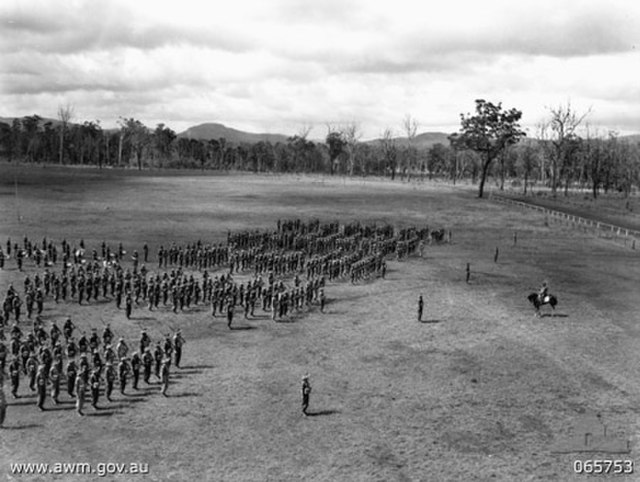2/1st Battalion (Australia)
The 2/1st Battalion was an infantry battalion of the Australian Army. Formed as part of the Second Australian Imperial Force at the start of World War II, the battalion was deployed to the Middle East in early 1940 and subsequently took part in the early fighting in the North African campaign, taking part in battles around Bardia and Tobruk before later being sent to Greece in early 1941. A lightning German advance quickly pushed the Allies back and forced them to evacuate after a very short campaign and the 2/1st was landed on Crete where they subsequently fought unsuccessfully to repel a German invasion in May. The majority of the battalion was captured on Crete, but the 2/1st was subsequently re-built from survivors in Palestine and returned to Australia in early 1942 following Japan's entry into the war. They then fought two campaigns against the Japanese in New Guinea, fighting in the Kokoda Track campaign during 1942–43 and the Aitape–Wewak campaign in 1944–45. Following the war, the 2/1st was disbanded.

Troops from the 2/1st at Wondecla, Queensland, April 1944
Troops from the 16th Brigade, including some from the 2/1st Battalion, cross the Owen Stanleys in October 1942.
The Battle of Bardia was fought between 3 and 5 January 1941, as part of Operation Compass, the first British military operation of the Western Desert campaign of the Second World War. It was the first battle of the war in which an Australian Army formation took part, the first to be commanded by an Australian general and the first to be planned by an Australian staff. The 6th Australian Division assaulted the strongly held Italian fortress of Bardia, Libya, assisted by air support and naval gunfire and under the cover of an artillery barrage. The 16th Australian Infantry Brigade attacked at dawn from the west, where the defences were known to be weak. Sappers blew gaps in the barbed wire with Bangalore torpedoes and filled in and broke down the sides of the anti-tank ditch with picks and shovels. This allowed the infantry and 23 Matilda II tanks of the 7th Royal Tank Regiment to enter the fortress and capture all their objectives, along with 8,000 prisoners.

Australian troops enter Bardia, 4 January 1941
Captured Italian L3 tankettes. In the background is the township of Bardia and its small harbour. Lower Bardia is in the middle distance; upper Bardia is atop the cliffs in the background.
Senior officers of the 6th Division. Front row, left to right: Brigadier Arthur Allen, 16th Infantry Brigade; Major General Iven Mackay; Brigadier Horace Robertson, 19th Infantry Brigade. Back row, left to right: Colonel Frank Berryman, GSO1; Brigadier Stanley Savige, 17th Infantry Brigade; Colonel Alan Vasey, AA&QMG. All six had been awarded the Distinguished Service Order in the Great War.
Gloster Gladiator biplane aircraft from No. 3 Squadron RAAF, returning to a landing ground near Sallum, after a patrol over Bardia.






